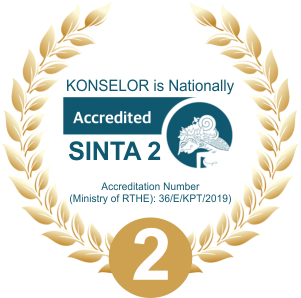A confirmatory factor analysis of social anxiety scale for adolescence (SAS-A) in Indonesian form
 ),
), (1) Universitas Pendidikan Ganesha
(2) Universitas Pendidikan Ganesha
 Corresponding Author
Corresponding Author
Copyright (c) 2019 I Putu Agus Apriliana
DOI : https://doi.org/10.24036/0201983105819-0-00
Full Text:
 Language : id
Language : id
Abstract
Keywords
References
Albano, A. M. (1995). Treatment of social anxiety in adolescents. Cognitive and Behavioral Practice, 2(2), 271-298.
Association, A. P. (2013). Diagnostic and Statistical Manual of Mental Disorders, 5th edn (Washington, DC: APA).
Beesdo, K., Knappe, S., & Pine, D. S. (2009). Anxiety and anxiety disorders in children and adolescents: developmental issues and implications for DSM-V. Psychiatric Clinics, 32(3), 483-524.
Brook, C. A., & Willoughby, T. (2015). The social ties that bind: Social anxiety and academic achievement across the university years. Journal of Youth and Adolescence, 44(5), 1139-1152.
Brown, T. A., & Moore, M. T. (2012). Confirmatory factor analysis. Handbook of structural equation modeling, 361-379.
de Lijster, J. M., Dieleman, G. C., Utens, E. M., Dierckx, B., Wierenga, M., Verhulst, F. C., & Legerstee, J. S. (2018). Social and academic functioning in adolescents with anxiety disorders: A systematic review. Journal of Affective Disorders, 230, 108-117.
Delgado, B., García-Fernández, J. M., Martínez-Monteagudo, M. C., Inglés, C. J., Marzo, J. C., La Greca, A. M., & Hugon, M. (2019). Social anxiety scale for adolescents and school anxiety inventory: psychometric properties in French adolescents. Child Psychiatry & Human Development, 50(1), 13-26.
Essau, C. A., Conradt, J., & Petermann, F. (1999). Frequency and comorbidity of social phobia and social fears in adolescents. Behaviour research and therapy, 37(9), 831-843.
Hayajneh, A. A. (2019). The Psychometric Properties of the Arabic Version of the Tilburg Frailty Indicator. Global Journal of Health Science, 11(9).
Hofmann, S. G., & DiBartolo, P. M. (2014). Social anxiety: Clinical, developmental, and social perspectives: Elsevier.
Inderbitzen-Nolan, H. M., & Walters, K. S. (2000). Social Anxiety Scale for Adolescents: Normative data and further evidence of construct validity. Journal of Clinical Child Psychology, 29(3), 360-371.
Miers, A., Blöte, A., De Rooij, M., Bokhorst, C., & Westenberg, P. (2013). Trajectories of social anxiety during adolescence and relations with cognition, social competence, and temperament. Journal of abnormal child psychology, 41(1), 97-110.
Morrison, A. S., Mateen, M. A., Brozovich, F. A., Zaki, J., Goldin, P. R., Heimberg, R. G., & Gross, J. J. (2019). Changes in Empathy Mediate the Effects of Cognitive Behavioral Group Therapy but not Mindfulness-Based Stress Reduction for Social Anxiety Disorder. Behavior Therapy.
Nelemans, S. A., Meeus, W. H., Branje, S. J., Van Leeuwen, K., Colpin, H., Verschueren, K., & Goossens, L. (2019). Social Anxiety Scale for Adolescents (SAS-A) Short Form: Longitudinal measurement invariance in two community samples of youth. Assessment, 26(2), 235-248.
O’Connor, C. E., & Fitzgerald, A. (2018). A Psychometric Evaluation of the Social Anxiety Scale for Adolescents in an Educational Setting. Journal of Psychoeducational Assessment, 0734282918816843.
Olivares, J., Ruiz, J., Hidalgo, M. D., García-López, L. J., Rosa, A. I., & Piqueras, J. A. (2005). Social Anxiety Scale for Adolescents (SAS-A): Psychometric properties in a Spanish-speaking population. International Journal of Clinical and Health Psychology, 5(1), 85-97.
Parry, S. (2017). Fit Statistics commonly reported for CFA and SEM. Cornell Statistical Consulting Unit: Cornell University.
Piray, P., Ly, V., Roelofs, K., Cools, R., & Toni, I. (2019). Emotionally aversive cues suppress neural systems underlying optimal learning in socially anxious individuals. Journal of Neuroscience, 39(8), 1445-1456.
Prawoto, Y. B. (2010). Hubungan antara konsep diri dengan kecemasan sosial pada remaja kelas XI SMA Kristen 2 Surakarta. Universitas Sebelas Maret,
Ronchi, L., Banerjee, R., & Lecce, S. (2019). Theory of mind and peer relationships: The role of social anxiety. Social Development.
Untari, R. T., Bahri, S., & Fajriani, F. (2017). Pengaruh Harga Diri terhadap Kecemasan Sosial Remaja pada Siswa di SMA Negeri Banda Aceh. JIMBK: Jurnal Ilmiah Mahasiswa Bimbingan & Konseling, 2(2).
Veed, G. J., McGinley, M., & Crockett, L. J. (2019). Friendship network influence on the development of internalizing symptoms during adolescence. Journal of applied developmental psychology, 60, 157-165.
Young, K. S., Burklund, L. J., Torre, J. B., Saxbe, D., Lieberman, M. D., & Craske, M. G. (2017). Treatment for social anxiety disorder alters functional connectivity in emotion regulation neural circuitry. Psychiatry Research: Neuroimaging, 261, 44-51.
 Article Metrics
Article Metrics
 Abstract Views : 3447 times
Abstract Views : 3447 times
 PDF Downloaded : 1337 times
PDF Downloaded : 1337 times
Refbacks
- There are currently no refbacks.
Copyright (c) 2019 I Putu Agus Apriliana

This work is licensed under a Creative Commons Attribution 4.0 International License.







